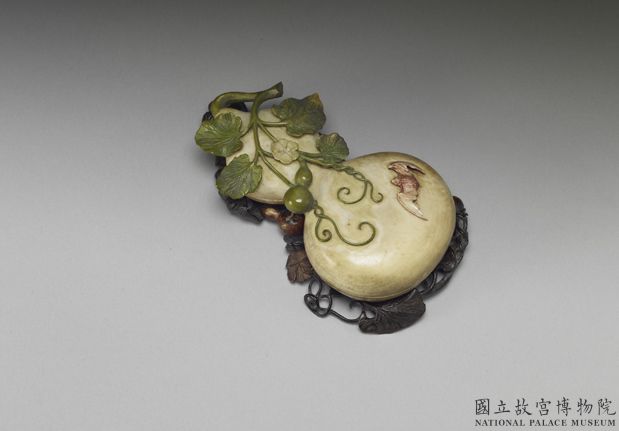Ivory bottle-gourd (calabash) box with a stand, 18th century.
- Image Number: K1G000184N000000000PAD
- Dynasty: Qing dynasty
- Category: Carvings
- Function: Stationery
- Material: Animal/Tooth/Ivory
- Description:
The whole vessel is in the shape of Pu Lu Gou, with the mouth of mother and son. The craftsman carved a vine from the base of the melon to turn on the cover. The cover is embossed with four leaves, two on the right and two on the back. The right one is embossed with leaf veins, and the back is embossed with leaf veins. The other one is decorated with a six petal flower, a small papyrus melon. The vine, leaves and small papyrus melon are all dyed green, and the six petal flower is lightly dyed green; At the lower right side of the cover, a slightly flanked bat is embossed and dyed dark red. “Bat” and “blessing” sound the same. Pulu melon means “melon is continuous”, which means that there are many descendants, and it also means “ten thousand years” and “ten thousand generations”. The decorative patterns on the body are considerable, and the attached alizarin base is more exquisite. Another piece of ivories is taken from the base to carve a winding vine. There are two reed melons hanging in it, two six petal flowers, and thirteen melon leaves are densely covered. The melon leaves are either positive or negative. The positive ones are also engraved with leaf veins, while the negative ones are embossed with leaf veins. The front of the utensil is sunken in the shape of a Pulu melon to receive a Pulu box. In order to imitate the color of the wooden lacquers, the whole vessel is dyed dark brown. The craftsman imitates the ivory seat into a wooden seat, which is easy to be fooled if not carefully observed.

![图片[2]-Ivory bottle-gourd (calabash) box with a stand, 18th century.-China Archive](https://chinaarchive.net/Qing dynasty/Carvings/K1G000184N000000000PAD-80293.jpg)
Pictures & Images [HD] download
© Copyright
The copyright of the article belongs to the author, please keep the original link for reprinting.
THE END



![[Qing Dynasty] British female painter—Elizabeth Keith, using woodblock prints to record China from the late Qing Dynasty to the early Republic of China—1915-China Archive](https://chinaarchive.net/wp-content/uploads/2022/11/image-191x300.png)

